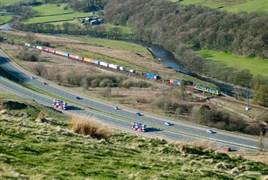 Read the peer reviews for this feature.
Read the peer reviews for this feature.
Download the graphs for this feature.
A few weeks ago I met with Anthony Smith, chief executive of Passenger Focus. Ironically, our meeting was to discuss roads, and the new role that his organisation is set to acquire representing users on the strategic road network. But the conversation moved on - as they do - and we found ourselves discussing passenger priorities for the railway.
What surprised me, although perhaps it shouldn’t, is that the themes raised by passengers are so consistent whenever and wherever they are asked. That is not to belittle them in any way, or to underestimate how difficult they can be to satisfy, but I was struck by how different their views are - both in topic and approach - to those regularly expressed by freight customers.
I was reflecting on this at the Rail Freight Group summer meeting, at which Drax Power, one of rail freight’s larger customers, set out its expectations and priorities for rail freight.
The list was distinctly different from those expressed by passengers, focusing on cost efficiency, management of network capacity and securing return on investment. But ask a user in the retail sector what their issues are, and you will get a different list again.
So what do freight customers want? And how are we, as an industry, responding to that?
The rail freight market today
To understand why freight customer views differ, you need to start by understanding the market.
Today, around 22 billion tonne-kms of rail freight is moved, up 6% in the last year. Research from the Rail Delivery Group shows that the value of the goods moved is over £30 billion, and that collectively the sector contributes over £1.5bn to the economy, keeping 7.6 million lorries off the road.
Yet the rail freight market is not homogeneous. The different sectors that contribute to that total face very different market conditions, future trends and supply chain needs.
Coal, the traditional bedrock of rail freight, still represents around a third of all business. Because domestic coal production has mostly ceased, with the exception of the Scottish open cast business, the vast majority of traffic now links ports and power stations rather than the traditional flows from mines.
Many ports are involved in the supply of coal, including east coast locations such as Immingham and Hull, and Bristol and Liverpool on the west coast. Traffic runs to the large coal-fired power stations, such as Drax, Ferrybridge, Fiddlers Ferry and Cottam.
As you would expect, coal movement is seasonal as power demand rises and falls with the weather. The share of coal generation is driven by the relative prices of coal and gas (the latter is particularly volatile).
Supply chains are also complex. To ensure security of supply, power stations use a diverse range of ports and rail operators, booking deliveries across them on a week-by-week basis. Little wonder that coal flows are so complex on the network!
Coal generation is under pressure from environmental legislation, and we have recently seen a number of power station closures - including Didcot, whose landmark cooling towers were demolished in July.
However, the remaining fossil fuel power stations still have a decade of useful life ahead, and the recent Budget made changes to the rate of carbon tax that appear likely to stabilise coal generation over the coming years. It is of note that last winter, coal generation accounted for almost 40% of all UK electricity needs, despite a rise in the share of renewables.
Coal is not the only commodity moved for the power sector. Partial or full conversion of some generators to handle biomass (pelletised wood) has opened a new market for rail freight, and necessitated significant investment in wagons and loading facilities to accommodate this new fuel. It is still unclear how many generating units might convert, but with government support confirmed to 2027 for those that are, there will be significant opportunities in this market.
Away from coal, the other large bulk commodity group is construction materials. Last year this grew by 17%, as the economy pulled out of recession and building activity began to resume.
Materials moved include stone (limestone and granite), sand and gravel and cement used in the building industry, as well as other smaller flows of gypsum, pulverised flue ash, construction waste and other materials.
The movement of construction materials on rail owes much to the nation’s geography. Hard stone mainly occurs north of the so-called ‘stone line’ that extends from the Severn estuary to the Wash, while sand and gravel occurs to the south.
As the foolish man discovered to his peril, you cannot build a house on sand, so hard rock must be imported to the London and South East region to support any kind of significant construction activity. Hence the main rail flows come from the quarries in the Mendips, East Midlands and Peak District to terminals in the South East. Increasingly we are also seeing flows into other conurbations such as Manchester and Leeds, while sand and gravel moves back in the other direction.
Rail’s increasing role is also being influenced by the minerals planning regime. Getting new extraction consents is difficult and costly, so as smaller and older quarries become expired, there is more focus on the larger sites with longer permissions. This tends to work to rail’s benefit, as haul lengths from these ‘super’ quarries to market are greater. This trend has already contributed to the sector’s growth in recent years, and we expect it to continue.











